Adventures with Wix
Wix Events Step-by-Step Setup Guide: Full Event Configuration
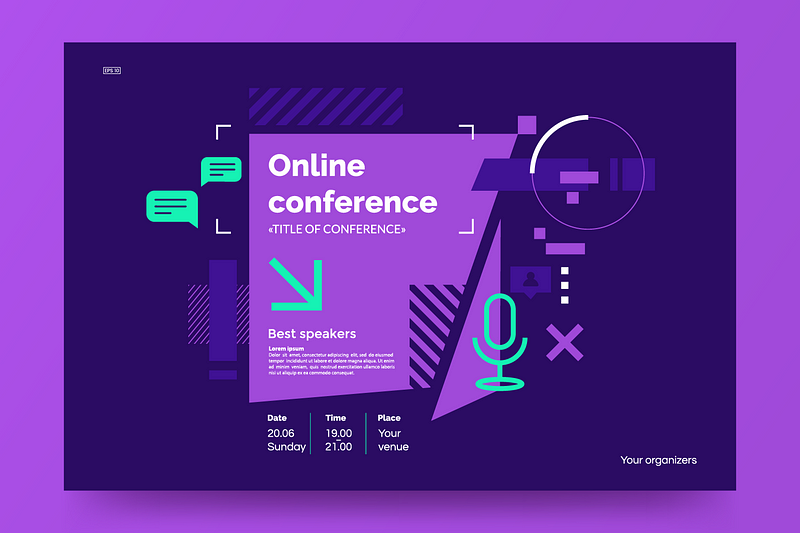
Welcome back to our series on creating a fully featured event on your Wix Website using the Wix Events App.
I’m super excited to cover how we can go about configuring our event to maximise the value it brings to our customers, which will in turn increase our sales.
So let’s get our ‘Customer Service’ hats on and get into it!
Series Structure
This in-depth tutorial series teaches you everything you need to know to setup and publish events using the Wix Events app. You’ll learn how to:
- Setup an event
- Use Wix’s built in CRM (Ascend by Wix) to automate informing and serving your customers
- Implement game changing workflows to level up the actionable insights you gain about your business
- Gather feedback from your customers at key points in their event attendance with you
Each episode has a full list of the episodes at the bottom and solves a particular part of the puzzle.
If you need extra help, don’t hesitate to reach out to my company Creative Appnologies. We would love to help you ❤️
In This Episode
In this episode, we’ll be diving into how to configure your Wix Event. We’ll be covering the following:
- Configuring your event details
- Creating your tickets
- Setting up your registration settings, including event policies
By the end of the episode, you’ll have a fully configured event ready to go for your website.
Super cool!
Event Details
The Event details section of our new event is where we update more details about our event.
It’s a section which deals with a lot of customer facing items — things they’ll directly see. Therefore, it’s definitely worth taking some time to get the details right!

There’s a couple of gotcha’s in this section, so let’s get into it.
General Section
The general section deals with an overview of the event. There’s not too much to worry about here, so I’ll just list them out.
- Event name. As it suggests, this is the name of the event. In our case, I’ve called it ‘Meet New Customers’.
- Short teaser. This is an optional section. It’s a great section to give your prospects and leads a bit more insight into what the event is about.
- Image. This is typically just represented as a + sign inside a rectangle, but it’s the section where you add an image for your event.
- Event category. This was created in episode 1 and it allows us to group our events together. It’s particularly useful if you have a number of different events which you want to group together.
Here’s what my section looked like:
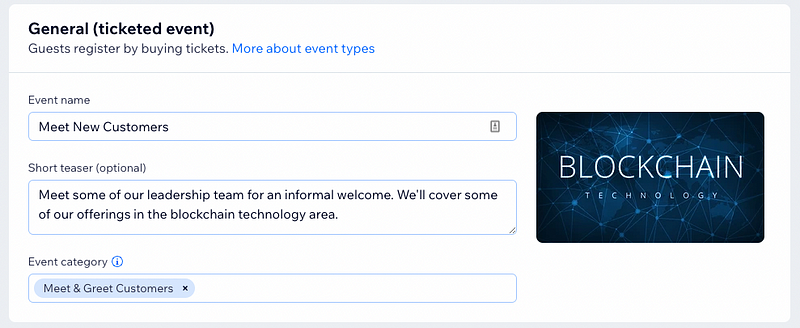
Date and time
Once again, this should be a pretty straightforward setup. The only gotcha here is the ‘Time is TBD’ option. If you toggle this on (i.e. you don’t display a set date / time), be aware that you will not be able to use the Video Conferencing option later on.
The rest of the options are pretty much as you’d expect
- Single event OR Recurring event. As you might expect, this allows you to choose if you want your event to be a one off or a recurring event.
- Start Date & Time. If you have not set your event to be TBD, then you need to set the Start Date and time. You will also need to set your timezone
- End Date & Time. If needed, set the end time.
- Display timezone. This can be a really useful option if you’re an international business at it will display your timezone at the time of booking.
Here’s what mine looked like:
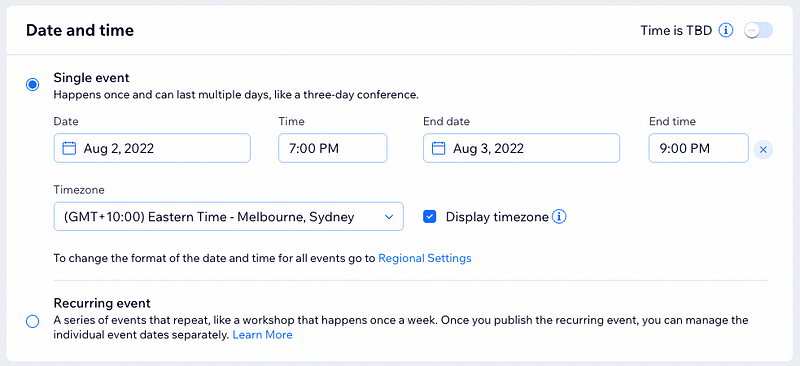
Location
The location section deals with where the event takes place. You’ve got three broad options: Physical location, Online or ‘Location is TBD’.
If you choose ‘Online’ the only other option you need to select is the Online Location Title.
If you choose ‘Physical location’, then you need to add the address where the event will take place.
If you choose ‘Location is TBD’, then that’s all you need to do 😃
Here’s what my Online event looked like:
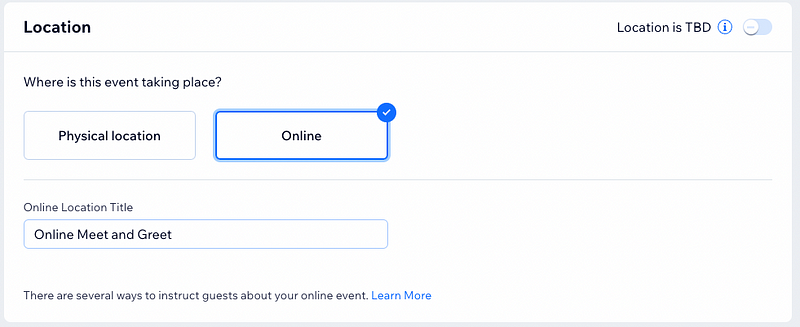
Video Conferencing
In the post-pandemic world (also called our new normal), video conferencing is ubiquitous (which means everywhere). Taking your events online wherever possible expands your reach and target market penetration for many companies.
Wix allows you to fully integrate an online experience for your customers. You can do this as a purely online only event, or hold an event which has an online component as well as a physical location.
Out-of-the-box with Wix, you have two choices. Wix Live is a solution hosted right inside of your Wix Website and managed through your dashboard. It’s a surprisingly fully featured option, with a bunch of useful features such as individual links, multiple hosts, chat messages and recording. You also get 3 free events, which allows you see if it’ll work for you. I haven’t been able to figure out who Wix uses as their video conferencing provider or if they developed their own native solution, but regardless, it’s a great option to check out.
Your other option is Zoom. This requires a bit more setup, but integrates quite effectively with the events option. You need to use a combination of your Zoom settings and Wix website settings to fully manage options such as individual access codes etc.
One consideration for your Zoom vs Wix Live choice is the lack of Wix Live integration with the Wix Bookings app. This means that you cannot use Wix Live (at the time of writing) for any one on one meetings.
Using Wix Live, here’s what I chose:
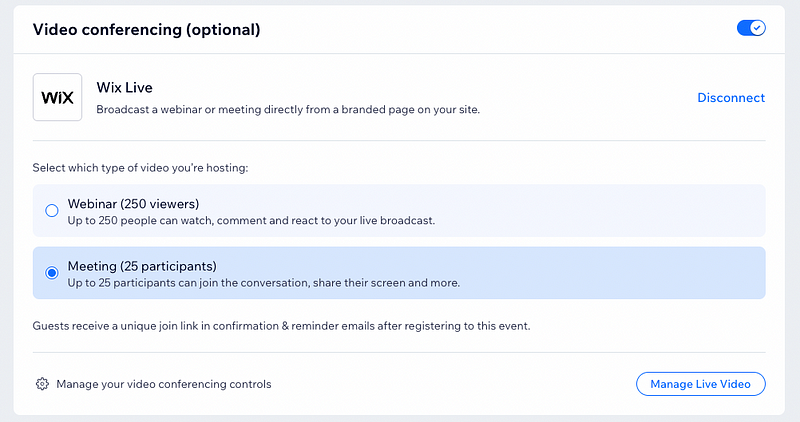
Event Schedule
The next section allows us to set up a schedule for our event. There’s a couple of complexities here, so let me outline them for you.
- Enable Personal Agenda. With the Wix Events app, you can enable a personal agenda. This means that you give your customers the ability to choose their own adventure for your offering. It also means you need to ensure that all of your options are loaded 😉
- Adding items. Adding items is pretty simple, but make sure you check your start date & time.

Here’s what my schedule looked like once done:
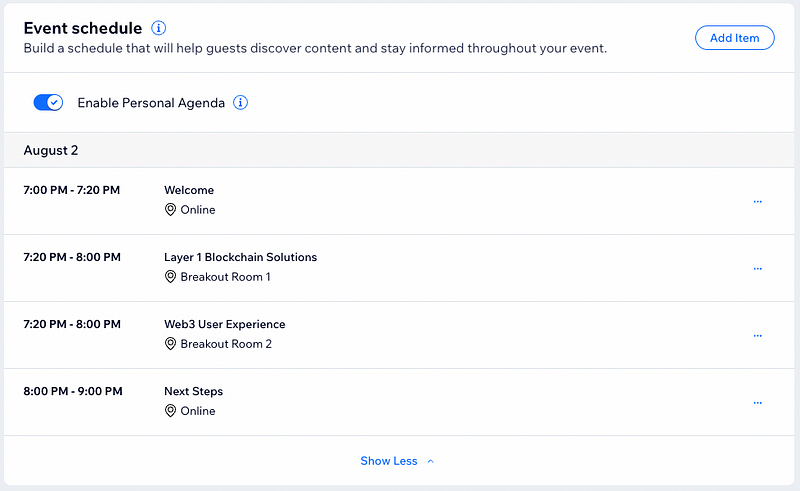
About the Event
This is an optional section where you can expand more on the event. It’s helpful if you want to go into more detail than allowed in the ‘Short teaser’ part in the ‘General’ section.
I didn’t fill this out for this event.
Group (optional)
A potentially great option for your website is connecting up a group. This can be awesome if you’re looking to create a social buzz / atmosphere around your event.
There’s a couple of things to be aware of here:
- Default Settings. Wix’s default settings for group is (in my own words) ‘Make everything visible to everyone’. This may not work for you or your customers, so make sure you think through this and configure it correctly if needed.
- Terms & Conditions. If you’re looking to share information about others (which is what a group does), then make sure you’re covered by some terms & conditions. This will protect you, as well making sure your customers know what to expect.
For this event, I haven’t set up a group. My reasoning for this is that I’m meeting new customers — which is not the time to be sharing their details around in a group.
Save Draft
Alrighty, we’ve finished setting up our event details so save the draft and let’s move to the next section.

Tickets
The next component of configuring our event is setting up our tickets. It is in this section that we start to create our pricing models, which we’ll use in future episodes.
Create a Seating Map
Although it’s not relevant for the event I’ve been creating (online), I’ll cover setting up a seating map here.
A seating map allows you to achieve a couple of things:
- Organise the flow of people more efficiently — i.e. people will know where they will be sitting, so will self direct.
- Create tiered pricing models — i.e. ‘if you pay more you get to sit closer’
- Enable group seating
If you desire to go down this route, here’s how you do it.
- Choose ‘Create a Seating Map’
2. Choose your template (or start with a blank template) then ‘Create Map’
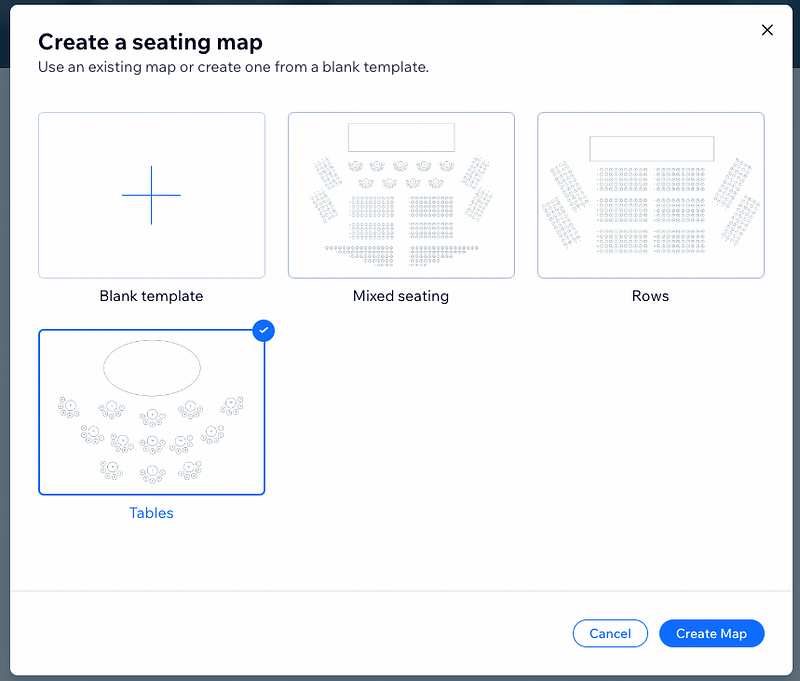
3. Fill out the details of your template. For instance if you chose ‘Tables’ you would fill out this map:
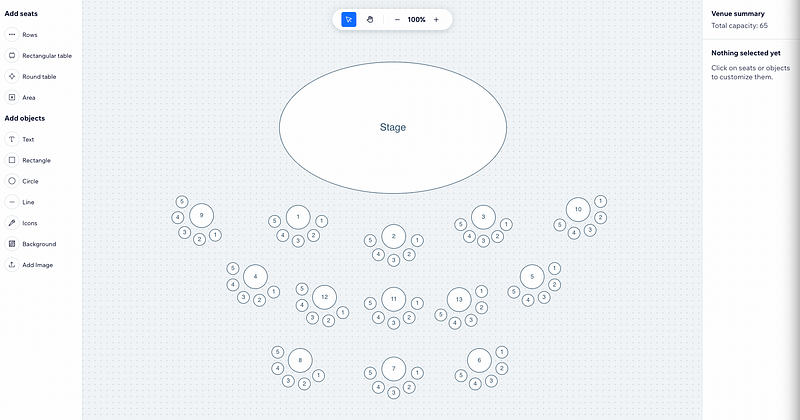
That’s it! Here’s what I ended up with:
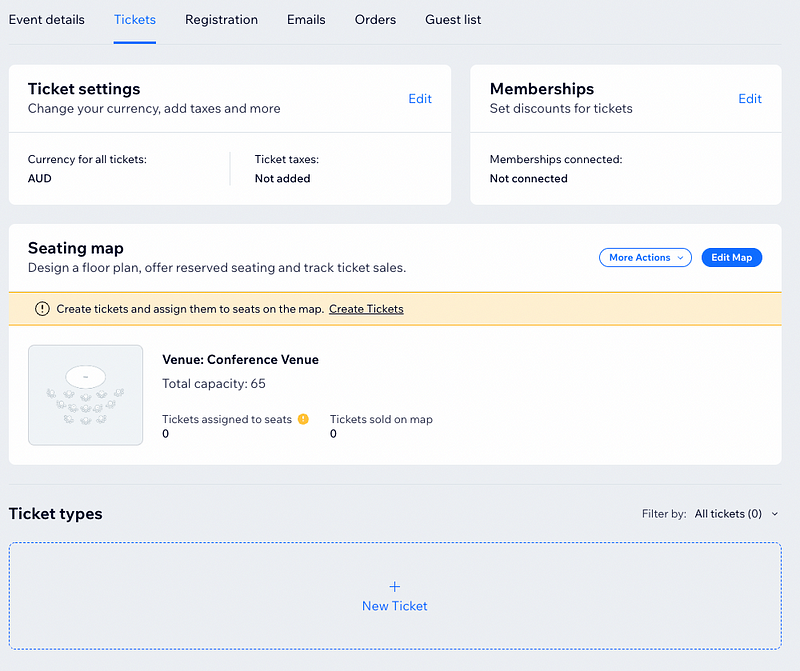
You’ll also notice that Wix is now prompting me to create tickets which are assigned to specific seats.
Very cool, and very straightforward!
Create Tickets
We’re now at the stage of creating tickets. Depending on how you’re following me through the tutorial, you’ll either have the previous screen, or the one below. So let’s go with creating our tickets.
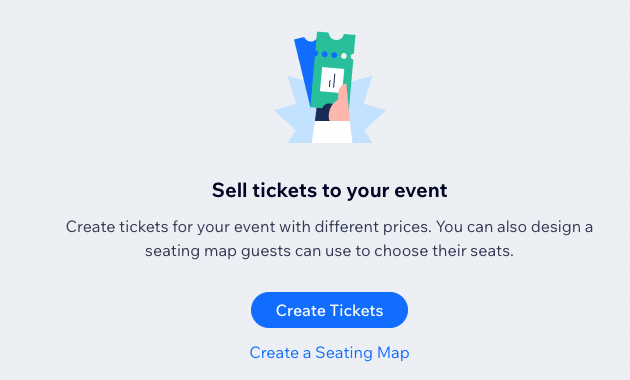
Using the ‘Create Tickets’ OR ‘+ New Ticket’ option, start to fill out some details:
- Ticket name. This can be something like ‘General Admission’ or link it to your seating plan.
- Description. A short description of the ticket
- Pricing method. Note the option here for ‘Pay what you want’ which can be great for a more motivational type offering.
- Ticket Price (if not free). This includes the currency being offered.
- Add a Discount Coupon. You cannot use this option until the ticket has been created.
- Ticket fees (and who pays it). This is the fee that Wix will charge you for using the Wix Events app.
- Ticket policy.
- Advanced settings. This allows you to only sell tickets for a specific date and time.
Once done, Save the ticket. Here’s what mine looked like:

At this point you can go back into the app and apply your ticket to your seating map and some discount codes.
We will cover the discount codes later in this series.
Ticket settings
In the ticket settings section, we’re able to configure some general rules for our event.
- Currency. The currency we’ll be selling our tickets in.
- Tax. Some jurisdictions like Australia require taxes to be included in the price. This includes a Goods and Services Tax (GST).
- Ticket limit per order. This allows you to set the maximum number of tickets a single entity can purchase.
Here’s my settings (I set the ticket limit to 5):

Memberships
Demonstrating yet another superb simplification of using the Wix Events App, you can link discounts to Members of your site.
It’s pretty simple:
- Choose ‘Membership’ and Edit
- Select which members get the discount
- Choose the discount they get
- Choose how many tickets they can order
For instance, I chose to let my ‘Gold’ and ‘Business OS’ members get 100% discount (i.e. free) and Silver members 50%. They could only order 2 tickets at this price.
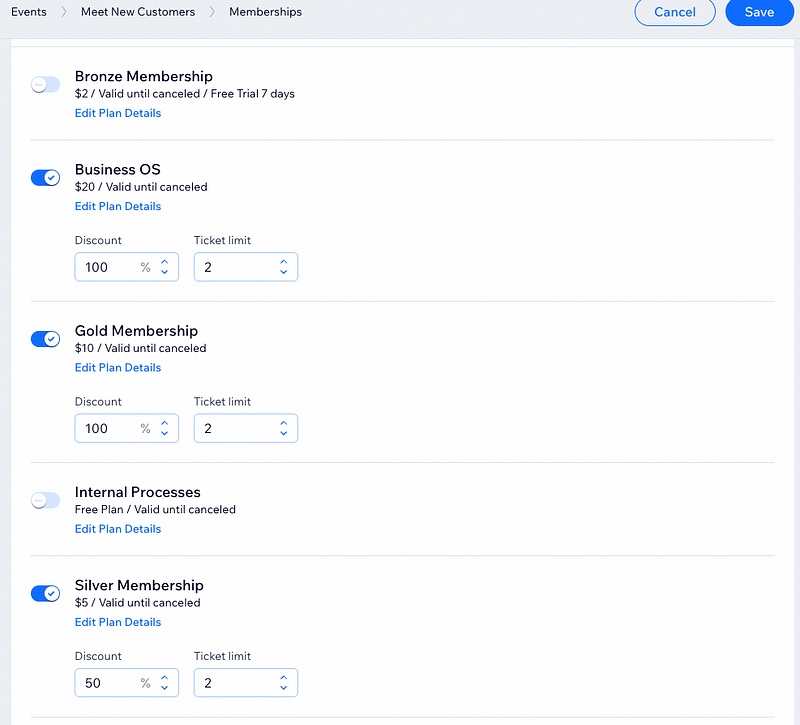
Registration
The final section in this episode is configuring our Wix Events Registration settings. Phew!
Our registrations allow us to manage things like our event policies, the information required at sign up and more. So let’s get into it.
Registration Settings
This setting simply determines our Registration channel. You only have three options here:
- Wix Events registration page. This simply means ‘on your wix website’. No configuration required.
- On a different page or web address. This is useful if you’re promoting you site somewhere else. If you choose this option you need to let Wix know the URL of that event page.
- Guests don’t need to register. Nothing else required. It is an ‘open’ event.
Customise your registration form
This section allows you specify the information you’ll gather about your guests.
One word of warning here: under most jurisdictions the information you collect about people is governed by privacy law. As you modify this section, ensure that you’ve consulted a relevant expert in your area and understand the information you’re collecting.
Here’s your options:
- Collect Guest Info. This allows you to choose between 1 registration form per order (i.e. if 1 person orders 20 tickets, you only get that one persons information) or 1 registration form for each ticket in an order (i.e. if a person orders 20 tickets, they must fill out the information for each ticket).
- Customise your registration form. This allows you to customise the information you’re gathering.
For my form, I didn’t need any more information than the standard options, so my form is pretty simple. Modify yours as needed 😃
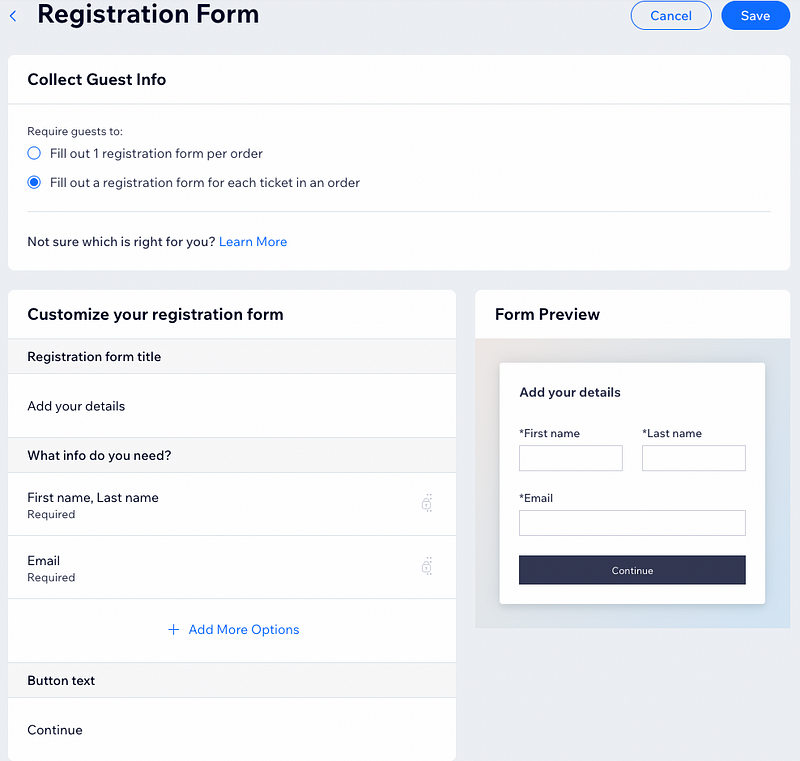
Event Policies
In this section you can add up to three policies for your event. This typically includes things like:
- Agreeing to Terms and Conditions (if not covered elsewhere on the site)
- Cancellation policies
- Dress code
- Disclaimers
To create an event policy, undertake the following:
- Choose ‘Create Policy’
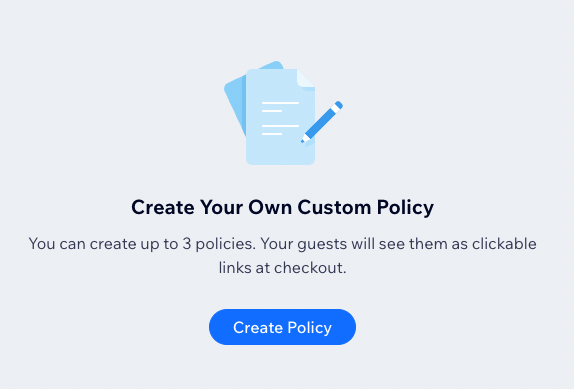
2. Fill in the policy info. Here’s an example
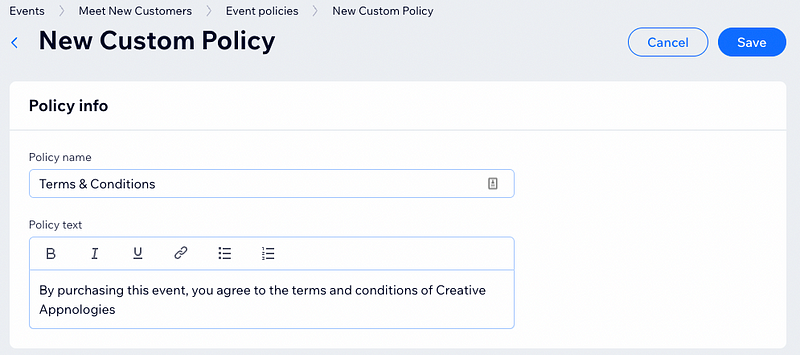
3. Save
Here’s what a completed one looks like:
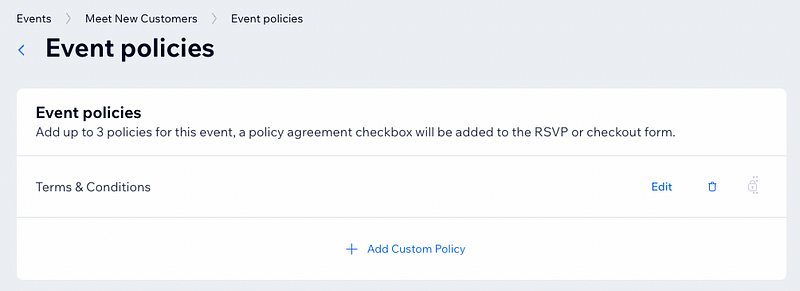
Registration messages
The final part of our registration settings is letting our guests know when registration is unavailable or closed. We do this through the registration settings.

And that’s it!
Next Steps
Alrighty!
We’ve now got a fully configured Wix Event ready to go. We could honestly publish it right now, so if that’s where you’re at, feel free to skip straight through to episode 4: Publishing An Event.
However, we can serve our customers even more effectively by filling out our CRM and getting their feedback. To do that, follow our next episode: CRM Basics.
List of Episodes
- Event and Feedback Setup
- Full Event Configuration
- Event CRM Basics
- Level Up with Wix Workflows
- Publishing Events on Wix Website
Follow Me
As with everything I write, I hope you find this helpful ❤️. It would mean the world to me if you took the time to give me a ‘clap’ on Medium, or subscribe to my email list. If you’re looking to subscribe to Medium, feel free to use my referral link (it doesn’t cost you any extra, but does mean I get a portion of your subscription fee).
Enjoy, and feel free to drop me a DM on twitter, connect on LinkedIn / Github with thoughts and comments 😃
